Follow my simple Pork Temperature Chart to cook your favorite pork chop recipes and more to perfection! This chart has all the information you need for pork tenderloin, pork chops, roasts, and even ham. Let’s get started!.
Some people in my family don’t like pork recipes as much as I do. If you eat too many dry, overcooked pork chops, you might think pork isn’t as good as beef or chicken.
But it has a lot to offer: if you cook pork just right, it turns into a tender, juicy protein that takes on the flavors of whatever you serve it with. Best of all, pork is more budget-friendly than ever, so you can save some money cooking it, too.
This pork temperature chart is great if you’re new to cooking pork or just want a better way to do it. Not to mention, I’ve included some of my family’s favorite pork recipes so you can test your skills!.
In general, the USDA says that pork chops and roasts should have an internal temperature of at least 145°F.
But depending on the cut, some cuts, like ground pork or precooked ham, may need a lower or higher internal temperature.
Keep reading to learn how hot different types of pork cuts should be inside, like pork chops, tenderloin, ham, and more!
No matter how they are cooked, bone-in or boneless pork chops must reach an internal temperature of 145°F to be fully cooked. Even though the standard used to be higher, if you cook your pork past 145°F, it is already too done.
Use an instant read meat thermometer to measure the temperature of your pork chops. To get the best results, take it off the heat as soon as it reaches the right temperature inside and let it rest for a while before cutting it.
As an avid home cook and pork lover, I’m always looking for ways to cook up the perfect juicy pork chop. After years of overcooking and ending up with dry tough pork, I finally learned the key is all about hitting the right internal temperature. It turns out there’s quite a bit of debate over the proper pork chop internal temp, but fortunately, the experts have it figured out.
In this article, I’ll share the ideal temperature for pork chops to turn out moist and delicious. I’ll explain how to use a meat thermometer correctly to check for doneness. And I’ll provide details on why today’s modern pork production methods make lower cooking temperatures safe. Read on to become a pork chop pro!
Why Temperature Matters
Cooking pork to the proper internal temperature is critical for two reasons
-
Safety – Pork needs to reach a high enough temperature to kill potentially harmful bacteria. In the past, trichinosis infections from undercooked pork were a concern, but improved production practices have made this extremely rare.
-
Texture – Cooking pork to the ideal finished temperature results in a tender, juicy interior with a browned, flavorful exterior. Overcooking leads to dry, rubbery pork chops.
So hitting the target temp is the key to pork chop perfection!
The Magic Number for Pork Chops
Here’s the temperature you need to memorize
145°F
The USDA and meat scientists agree that cooking pork to 145°F kills any potential parasites and bacteria. For whole cuts like chops, roasts, and loins, there’s no need to go higher. In fact, exceeding 145°F will cause the pork to become progressively drier and tougher.
As a former over-cooker, I admit it took some getting used to seeing a hint of pink when I sliced into a 145°F pork chop. But after tasting the incredible juiciness and flavor, I became a convert. Give it a try – proper medium rare pork is incredibly moist and delicious.
Use a Thermometer to Avoid Guessing
The only way to know your pork has reached the target internal temperature is to use a digital instant read thermometer. These affordable devices provide a quick, accurate temperature reading. Here are some tips for success:
-
Insert the probe into the thickest part of the chop, at least 1 inch from bone.
-
For accuracy, take temperature in more than one spot.
-
Double check calibration before cooking.
-
Wait until close to the expected finish time to start checking.
-
Allow the thermometer reading to stabilize before removing from the oven or grill.
A few seconds with a thermometer beats guessing and ending up with overcooked pork!
Why Today’s Pork is Safe at Lower Temps
In the past, undercooked pork posed a significant risk of transmitting trichinosis, a nasty parasite. Therefore, pork was cooked well done to 160°F or higher to kill any potential parasites.
But with modern production methods, this is no longer a concern:
-
Pigs are raised indoors in clean, controlled environments – not fed raw garbage or exposed to other trichinosis sources.
-
Government inspections and regulations ensure pork safety.
So go ahead and cook pork to a perfect medium rare 145°F – it’s completely safe and incredibly tasty!
Pork Chop Doneness Guidelines
While the145°F target is ideal for juicy pork chops, personal preference matters too. Here are USDA recommendations for other levels of doneness:
-
Medium: 150-155°F – A bit more interior browning with slightly firmer texture. Still juicy.
-
Medium Well: 155-160°F – Mostly browned through, starting to dry out.
-
Well Done: 160°F and up – Brown throughout, can become tough and dry if overcooked.
I suggest trying medium rare or medium to experience amazingly moist, delicious pork chops. But cook to your desired doneness and use a thermometer to nail it every time.
Master the Perfect Pork Chop
Cooking pork properly comes down to temperature. For the juiciest, most flavorful chops, target an internal temperature of 145°F. With today’s pork, this ensures moist, tender results with no safety concerns.
:max_bytes(150000):strip_icc()/SPR_3981295-timing-the-cooking-for-pork-chops-5a985c9e31283400373b2916.png)
Pork Shoulder Temperature (Pork Butt)
| Cooking Method | Internal Temperature |
|---|---|
| Smoked Pork Shoulder | 195°F to 205°F |
| Grilled Pork Shoulder | 195°F to 205°F |
Technically, pork shoulder, which is also known as pork butt, is done when it reaches 145°F. However, like beef chuck roast, this cut of meat tastes better when you cook it for longer.
Shoulder and butt are the best cuts of pork for pulled pork. Whether you grill, smoke, or slow-cook the meat, you want it to be fall-apart tender so it’s easy to shred and tastes the best.
For smaller pork butts, you may not need as high of a temperature. Aim for between 180°F to 190°F for a smaller cut.
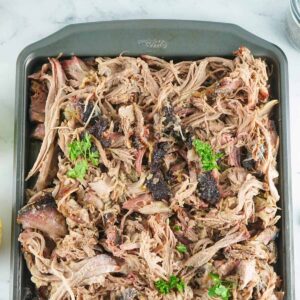
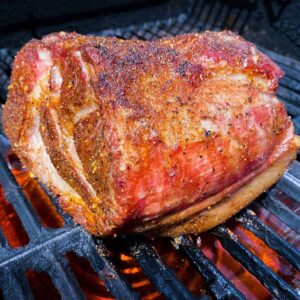
| Roast Pork Cut | Internal Temperature |
|---|---|
| Bone-in Pork Loin (rack of pork) | 145°F |
| Boneless Pork Loin | 145°F |
| Pork Tenderloin | 145°F |
Just as with pork chops, the ideal pork roast temperature is 145°F. When roasts reach 140°F, take them off the heat and let them rest for at least 10 minutes until they reach room temperature.
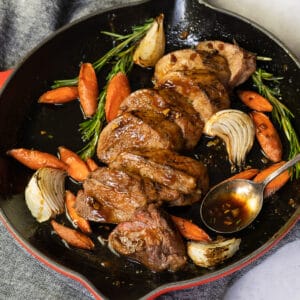

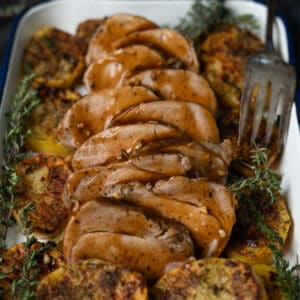
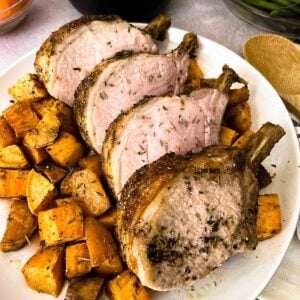
| Pork Ribs Cut | Internal Temperature |
|---|---|
| Baby Back Ribs | 198°F to 200°F |
| Spare Ribs | 198°F to 200°F |
| Country-Style Ribs | 205°F to 210°F |
| St. Louis-Style Ribs | 200°F to 205°F |
A higher temperature is better for pork ribs than the USDA standard. This is also true for pork shoulder and pork butt. For fall-off-the-bone results, cook all ribs to above 195°F.
However, some people prefer their ribs less fall-off-the-bone than this level of doneness. Aim for at least 145°F and no more than 180°F if you like your ribs to have a bit more chew. Cook them slowly.
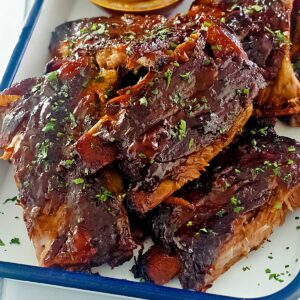

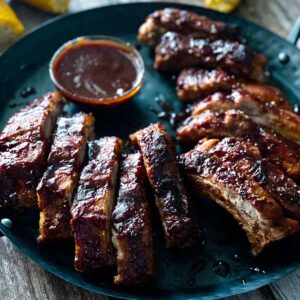
| Style of Pre-Cooked Ham | Internal Temperature |
|---|---|
| Boneless Ham | 140°F |
| Bone-in Ham | 140°F |
| Spiral Ham | 140°F |
| Ham Shank | 140°F |
| Ham Steak | 145°F |
Because most hams are purchased pre-cooked, they require a slightly lower temperature than pork purchased raw. If you purchase your ham uncooked, make sure to reach an internal temperature of 145°F.
If you don’t want your ham to dry out or get too cooked, you should use ham glaze to baste it before, during, and after cooking, and cover it with foil at the right times.
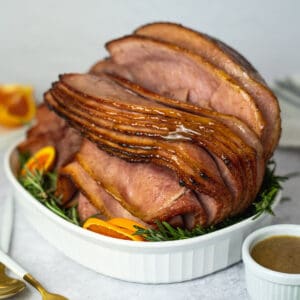
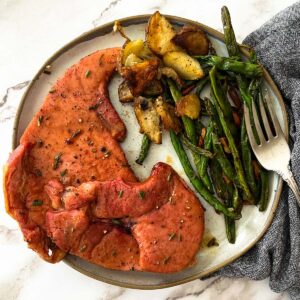
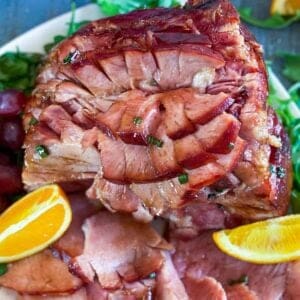
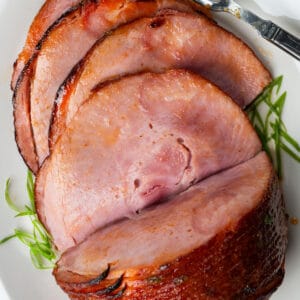

| Recipe | Internal Temperature |
|---|---|
| Ground Pork Burgers | 160°F |
| Ground Pork Meatballs | 160°F |
| Ground Pork Meatloaf | 160°F |
| Ground Pork Chili | 160°F |
| Ground Pork Tacos | 160°F |
| Plain Ground Pork | 160°F |
Food safety rules say that ground pork should always reach an internal temperature of 160°F, no matter what recipe you use or how you cook it. Make sure to use a meat thermometer to check the temperature of ground pork as necessary.
Because it is ground, ground pork needs to be cooked at a higher temperature than other cuts. This is because the process of grinding exposes the meat inside to bacteria from the outside. Cooking to 160°F kills this bacteria.
Pork Internal Temp FAQ
Some cuts of pork, like pork chops, cutlets, and roasts, are safe to eat at 145°F. If you cook them any higher, they are too done. Pork ribs are best cooked to a temperature above 190°F. However, ground pork requires an internal temperature of 160°F to be safe to eat.
There’s nothing wrong with pork being a little pink on the inside. It depends on how it was cooked (smoking makes meat more pink). Just like beef, this color of pork is considered “medium-rare”. To be sure that your pork is safe to eat, you need to use an internal meat thermometer to make sure that it reaches 145°F on the inside.
Cook Pork Chops to Perfection: The Ultimate Guide to Internal Temperature
FAQ
Are pork chops done at 160 degrees?
Can you eat pork chops at 150 degrees?
What temperature are pork chops most tender?
Can you cook pork chops to 145?
What temperature should pork chops be cooked to?
Always cook pork chops to 145°F. The once-held notion that all pork should be cooked to 160°F until it’s beige throughout has pretty much disappeared. Before 2010, USDA guidelines urged home cooks to cook all pork products all the way through, which left the resulting pork free from any potentially harmful bacteria but also pretty dry and tough.
What temperature should pork be cooked at?
“This is why whole muscle cuts of pork like roasts and chops are safe, juicy and flavorful at 145° internal temperature with a proper resting period.” If a medium-rare 145-150° isn’t desirable, then try additional temperatures from the National Pork Board: medium (150-155°), medium-well (155-160°) or well done (160°).
How do you check the internal temperature of a Pork Chop?
The easiest way to check the internal temperature of pork is by using an instant-read meat thermometer. To do so, slide the thermometer into the middle of the thickest part of the chop. Take care to stay in the middle of the chop without breaking through to the pan, which will affect the reading.
What temperature should a bone-in Pork Chop be cooked at?
For the bone-in pork chop, the bone will act as a heat shield. This means the meat closer to the bone will be rarer than the meat in the middle of the chop. Pulling it at 145 degrees will give you a moist and flavorful bone-in chop. The resting time will also raise the temperature 5 or so degrees to alleviate any concerns.
